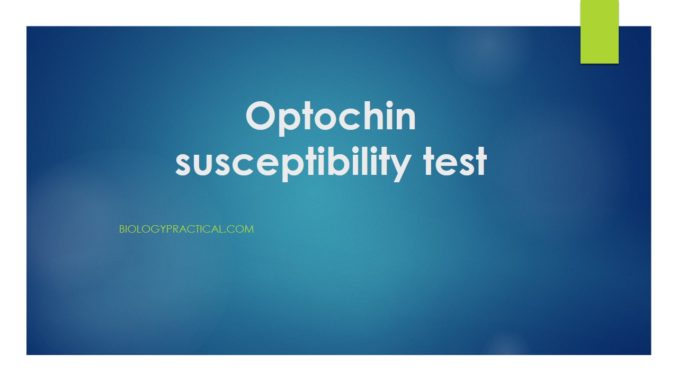
Principle of Optochin susceptibility test:
- Streptococcus pneumoniae is found generally on respiratory tract and has a hemolytic pattern identical to other alpha-hemolytic streptococci and lactobacilli. Streptococcus pneumoniae is sensitive to optochin i.e. cannot form colonies in its presence as it changes in surface tension and causes the cell membrane of Streptococcus pneumoniae to lyse. Optochin (ethylhydrocupreine hydrochloride) is a chemical which is quinine derivative and readily soluble in water. Since, all other alpha-hemolytic streptococcal species are resistant to optochin, optochin susceptibility test can be employed for the presumptive identification of optochin sensitive Streptococcus pneumoniae.
- For the determination of susceptibility of suspected Streptococcus pneumonia, filter paper disks impregnated with optochin can be used in a disk diffusion test. It is performed on blood agar. A zone of inhibition created due to the lysing of cell membranes of Streptococcus pneumonia cells surrounding the disk which determines positive test. This test is easy to perform, economic and has more than 95% sensitivity.
Requirements:
- 5% sheep blood agar
- Optochin disks (each disk impregnated with 5µg optochin)
- Incubator
- Sterile Inoculating loops
- Sterile forceps
Procedure of Optochin susceptibility test:
- Use an inoculating loop to streak 2-3 well isolated colonies of a pure culture to be tested on 5% blood agar.
- Use sterile forceps to place an optochin disk onto the inoculated surface of agar.
- Assure to adhere the disk firmly to the agar surfaces by use of either sterile forceps or loop.
- Keep the plates in incubator at 35-37°C.
- Observe the growth on blood agar plates and measure the diameter of zone of inhibition including the diameter of disk.
Results interpretations:
- Positive result:
- If the zone of inhibition is 14 mm or greater in diameter with 6 mm disk, it is suggestive of positive test.
- If zone of inhibition formed is less than 14 mm then, the strain is identified as pneumococcus only if it is bile soluble.
- Negative result:
- If no zone of inhibition is formed, the test is negative indicating the absence of Streptococcus pneumoniae.

Limitations:
- CO2 rich environment is required for the incubation of Streptococcus pneumoniae isolates.
- There are rare exceptions of Streptococcus pneumoniae being optochin resistant.
- As optochin susceptibility test is a presumptive test only, further biochemical tests should be performed for complete identification.
- If tube bile test has been performed for confirmation of strains with zone of inhibition between 7 and 14 mm, there is increase of sensitivity in detection of non-encapsulated strains, however bile resistant strains with intermediate zone sizes may still be S. pneumoniae thus further testing with DNA probe is necessary for identification.
